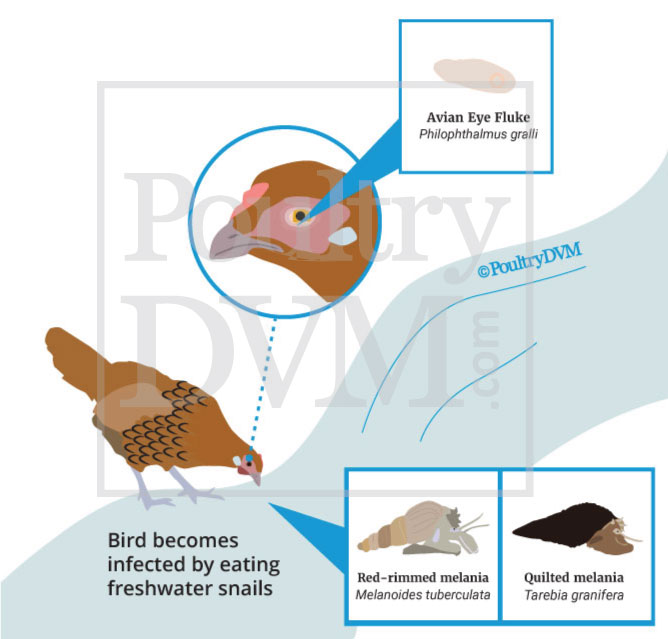The avian eye fluke,
Philophthalmus gralli is a zoonotic trematode which invades the conjunctival and orbital tissues of the eye of domestic and wild birds. On rare occasions
P. gralli can also infect humans.
P. gralli causes conjunctivitis and keratitis (inflammation of the cornea). In severe cases, corneal ulcers, perforation and blindness may also occur. There has been an increase in reports of avian philophthalmiasis in captive and wild birds, especially ostriches, tinamus major birds, and greater Rheas. The most frequent clinical signs observed in infested birds include conjunctivitis, epiphora (excessive lacrymation), pruritus (itching), blepharitis, ocular discharge, blepharospasm (involuntary eye closure), subconjunctival hemorrhage, and swelling of the eyelids.
How the Avian Eye Fluke is Transmitted to Chickens
Birds (usually aquatic birds) serve as the definitive host of
P. gralli. Adult
P. gralli live and reproduce in the eyes of their host. Embryonated eggs produced by
P. gralli are released into the water when their host is diving, foraging underwater or drinking. Upon contact with the water, these eggs hatch and release organisms referred to as miracidia. Miracidia seek out intermediate hosts (mollusks, snails, bivalves, aquatic insect larvae, crustaceans, frogs, fish and reptiles) where they will begin producing generations of rediae, which become cercariae. Cercariae are then released and encyst on the outer shell of their intermediate host or other stationary objects in the water where they become flask-shaped metacercariae. Chickens may become infected by ingesting the metacercariae on the intermediate host, aquatic plants, or through direct exposure to the eye from the water.
Two species of mollusks, the Red-rim Melania (
Melanoides tuberculata) and the Quilted melanie (
Tarebia granifera) are frequent intermediate hosts of
P. gralli.
Diagnosis and Treatment of Avian Philophthalmiasis
Avian philophthalmiasis is diagnosed by your veterinarian through an ophthalmic exam.
P. gralli can be visualized in the conjunctival sac and under the third eyelid. Treatment has to be performed by your veterinarian. It consists of the mechanical removal of
P. gralli with a swab or forceps and/or by flushing the conjunctival sac of the eyes.
